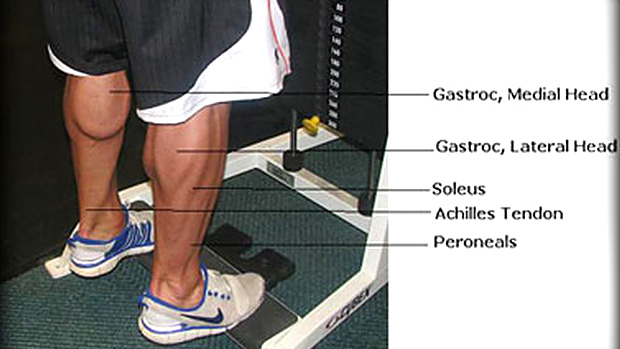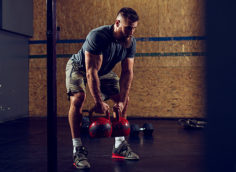Admit it. Calves are an afterthought in your program, aren't they? Yeah, you just toss in some machine calf raises at the end of your training session and call it a day, right?
You know what? We're not going to sit here trying to convince you that calves are worth training hard and training smart. You either want a complete physique or you don't.
But we will say this: If you're the guy doing nothing but three sets of ten on the standing calf machine at the ass-end of leg day when you're already exhausted, then we don't want to hear you bitch about "bad genetics." Ever.
Sadly, that's exactly how most people train calves. Even experienced lifters give up on their calf training, blame genetics, and barely hit them. It's an easy trap to fall into because the calves are tough to hypertrophy, unless you picked the right parents.
It's true, genetics do play a big role in calf development. "Calves are tricky," notes Chad Waterbury. "If they're small, no problem, they can get bigger. But if those calves have a very high insertion point (long tendon, short muscle belly) you're relegated to building calves that will, at best, look like half a grapefruit on a Popsicle stick. There's no way around it. But hey, that's better than looking like a strawberry on a Popsicle stick!"
So yes, there's a genetic "ceiling." But you, in all likelihood, aren't anywhere near yours, especially if you train calves as an afterthought. That's why we've put together this collection of our favorite calf training exercises and routines. But first, let's set some goals and have a quick review of "calfology."
Calf Development and the "Perfect" Physique
Do your calves stack up? Let's find out using bodybuilder Steve Reeves's pre-drugged era physique guidelines for aesthetic-minded lifters.
According to Reeves, the neck, upper arm, and calf should be approximately the same measurement. Reeves, being 6'1" and weighing 215 pounds, met these ideals by measuring 18 1/2 inches at the neck and 18 1/4 inches at the upper arms and calves.
Just for fun, take your measurements. How do you compare?
Calfology 101

A quick review:
- Without boring you to death by sounding like an anatomy textbook, the calves are composed of two main muscles: the soleus and the gastrocneimus, which has a lateral and medial head. Your soleus is worked mainly when your knees are bent (seated calf raise) and your gastrocs are worked mostly when your knees are locked (standing calf raise.) So as you can see, if you've only been doing one of those you're essentially "missing" half your calf. No wonder they suck!
- The soleus is mostly slow-twitch dominant, while the gastrocnemius is fast-twitch dominant. What that basically means is that you must primarily train your gastrocs with lower reps (3 to 6) and your soleus with higher reps (12 to 15). So, most of the time you'll want to perform low reps for standing stuff and higher reps for seated stuff. Just a rule of thumb, but also remember that rules of thumb are broken all the time to shock things up.
- Unless otherwise specified, you'll want to come all the way up on the concentric or lifting portion of the exercise (visualize coming up on your big toes) and go all the way down on the eccentric or lowering portion of the movement.
For maximal benefits, take a good pause at the bottom when you're in the stretched position. Waterbury explains:
"Bodybuilders can benefit from dissipating the stretch-shortening cycle (SSC) in order to recruit more motor units. Once the stored elastic energy has dissipated, the muscles must work harder to lift the load.
"Stubborn muscle groups such as calves are extremely efficient at storing potential energy during the reversal contraction phase. So, if you want to build bigger calves, you must force them to work harder and not 'cheat' with this stored energy. Therefore, hold a calf stretch for several seconds before performing a concentric contraction."
In other words, no partial-range, bouncy bullshit!
Enough review. Let's get to some routines that will – as Christian Thibaudeau says – put some cut in your strut!
1 – The Two-Minute Calf Raise

We're not against the good ol' standing calf raise machine; we just think most people overuse it or don't use it in a way to maximize its benefits. So here's a routine we learned from trainer and kinesiologist Tim Henriques that'll put some bang back into the standing calf machine.
- Select a weight that's 50 to 75% lighter than what you'd normally use for a set of 15.
- Perform a rep with a good squeeze at the top of the movement, then lower your heels all the way down until you're in a fully stretched position. (Note: You're still supporting the weight; it'll be pushing the calves down hard.) Hold that position for 10 full seconds. Keep an eye on a clock if you have to.
- Now do another rep, another 10 second stretch, and repeat for a total of 12 to 15 reps. If you time it right, this should be at least two minutes of constant tension.
- Repeat twice more for three sets total.
- Avoid taking the stairs for several days. (You've been warned.)
2 – Poliquin's Quick & Dirty Calf Solution
Talk to trainers and bodybuilders about calves and you'll the hear the word "stubborn" come up often. The calves just don't seem to want to grow, even if you persuade them with standard resistance training.
That's why many strength coaches employ "shock" techniques to force breakdown and subsequent muscle growth. Here's one of those techniques from Charles Poliquin.
- Start at the standing calf-raise machine. Perform eight reps with a two-second pause at the bottom of each rep.
- Rest 10 seconds.
- Load a barbell with about 25% of your body weight. Hold it in a squat position and, with minimal knee bend, jump up and down, bounding with the calves on each rep. Do this for 30 reps. "The eccentric damage caused by the landing will favor hypertrophy," notes Poliquin.
- Repeat the superset four more times.
"If that doesn't make your calves grow, nothing will!" says Charles.
3 – DeFranco's One-Minute Seated Calf Raise
For those who still like to train calves at the end of their workouts, Joe DeFranco has a tip: do seated calf raises for time.
"I do seated calf raises because my legs are so burned out at the end of my leg training that I can barely stand," admits DeFranco.
Instead of counting reps, DeFranco concentrates on doing as many as he can with good form and a controlled eccentric (negative), moving continuously for a full minute. Perform at least two sets.
4 – The Infamous Luke Sauder Calf Routine
The story goes like this: Luke Sauder, the alpine skier, walked into training camp one day with a new pair of calves. They were huge. So huge that he had to rush to get a new pair of ski boots molded.
Turns out that Poliquin had designed Sauder a calf program to help him avoid injuries (big strong calves result in fewer knee injuries for elite skiers).
Bet you want that program, don't ya, pencil-legs? Well here it is!
The Luke Sauder Calf Routine
This is a two-day routine, with 48 hours between sessions. In other words, you're going to train calves twice in a five-day cycle. One session is very high volume, the other is heavy with a lower volume. But don't you worry – they both hurt like hell.
Day 1 – High-Volume

- A1. Seated Calf Raises * 3 x 10-5-5 (one set of 10 reps, followed by two of 5 reps) at a 101 tempo (1 second to lower the weight, no pause, and 1 second to raise the weight)
- A2. Donkey Calf Raises 3 x 30-50 at a 101 tempo
- B. Standing Calf Raises * * 10 x 10-30 at a 111 tempo, ten seconds
* After finishing a set of the A1 exercise, proceed immediately to exercise A2. Then rest two minutes before repeating the super set.
* * In other words, you'll be doing one, long, extended set, resting ten seconds between each mini-set and lowering the weight in between.
"After day one, you'll probably have to call the fire department to extinguish the fire in your calves," says Poliquin (encouragingly?).
Day 2 – Low-Volume (48 hours after Day 1)
- A. Triple Drop Standing Calf Raises * 3 x 10-10-10 (in other words, three drop sets) at a 121 tempo, resting 90 seconds between sets.
* The pause is taken in the bottom stretch position, and be sure to take the full two seconds.
"This routine provides freaky size increases," Poliquin notes. "I've known people to gain in between 5/8ths of an inch to a full inch with this routine in as little as 30 days."
5 – The Less-Gay Donkey Calf Raise
Arnold did it by piling multiple sweaty men onto his back. But he's Arnold, and Arnold could get away with that shit. We prefer to do our donkey calf raise this way:
Strap on a loaded dipping belt and stand on a block, toes on the edge. Bend at the waist and do calf raises. You can perform them bilaterally or unilaterally. TC can perform them tri-laterally, the gifted bastard.
"The donkey calf raise places your gastrocnemius in a superior stretched position," notes Poliquin. If you haven't tried this one in a while, get ready for some intense soreness, regardless of how many standing and seated calf raises you've been doing!
6 – In Case of Emergency...
Stalled calf development is usually caused by weenie-boy training, bad genetics, or a combination of both. But let's assume your genetics are fine, you've tried every calf training trick in the book, and still have stork calves. The answer could be Active Release Technique or ART.
Basically, one of the regrettable side effects of years and years of weight training is the build-up of adhesions in soft tissues. Tight fascia is also believed to restrict muscle growth, and some pro-bodybuilders have reported near-instant size gains after treating these issues with Active Release.
Waterbury adds, "I can't count how many clients I've worked with who've benefited by fascial work. This is especially true with the calves."
If you think you have this problem, you can do some rolling around on a tennis ball or seek out an ART® provider.
For the whole scoop on Active Release, check out our interview with its creator, Dr. Mike Leahy.
A Final Tip
As we surveyed our strength coaches and hypertrophy experts, we noticed a common programming theme. Due to the mule-stubborn nature of calves, most all recommend high frequency training, hitting calves hard 3 to 6 times per week.
If you choose the extreme end of that range, don't forget to take a deloading/recovery week. "If you annihilate your calves, then every fourth week cut back to training them just once to allow supercompensation to occur," notes Chad Waterbury, who has recommended calf training up to six times per week for those in desperate need.
Remember, give these exercises and routines a try before you blame mom and dad. "Sweat often cures bad genetics," adds editor Chris Shugart.
Now go to it.
Models: Andrew Barker, Tim Smith
Location: Gold's Gym, Abilene, Texas





